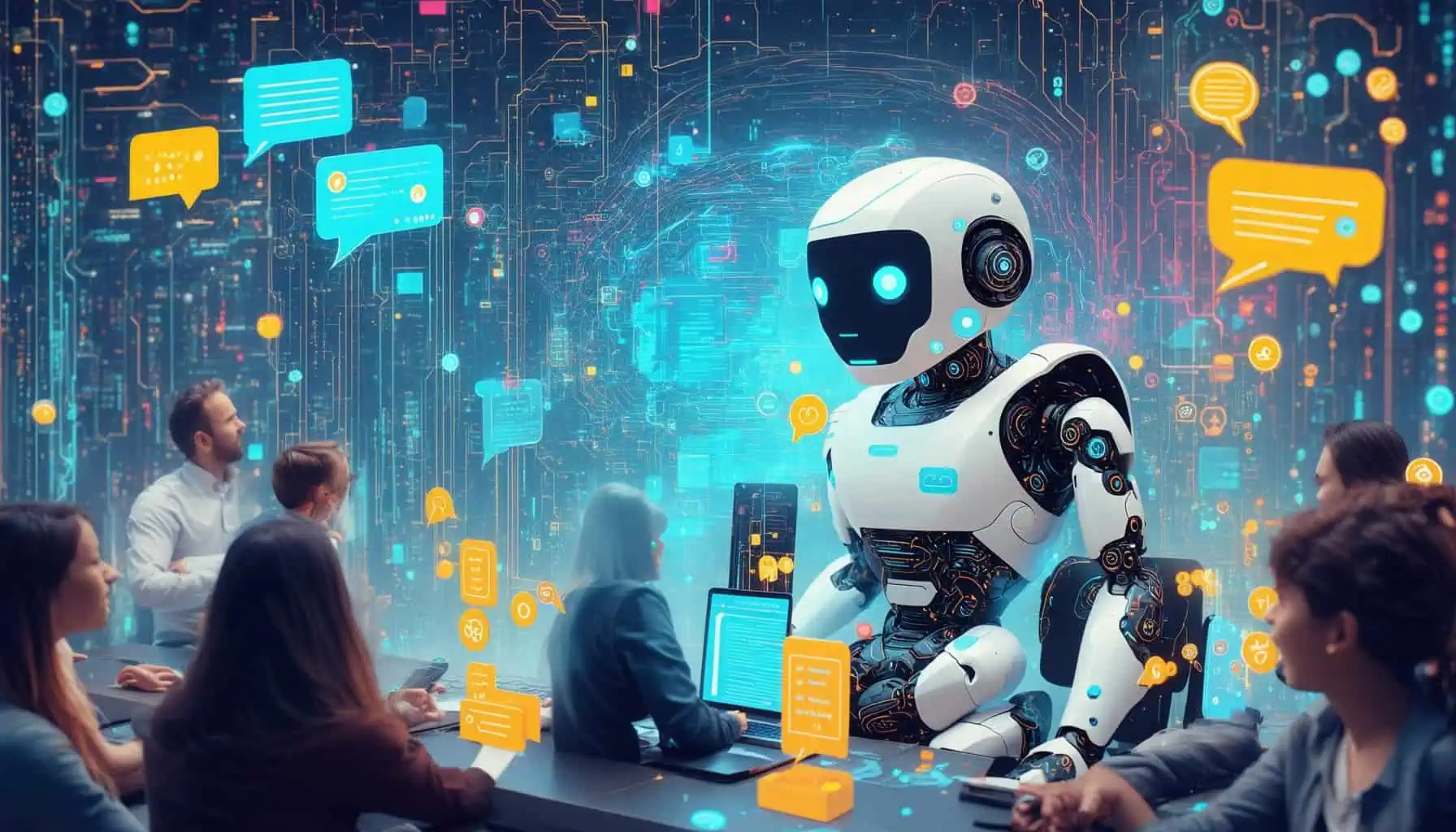Key Takeaways
- Types of Chatbots: Understand the differences between rule-based and AI-powered chatbots to choose the right solution for your needs.
- 24/7 Availability: Leverage chatbot interaction to provide round-the-clock customer service, enhancing user satisfaction and engagement.
- Cost Efficiency: Implementing chatbots can significantly reduce operational costs by automating responses and minimizing the need for human agents.
- Personalization: Advanced chatbots utilize data analysis to offer tailored responses, improving user experiences and fostering loyalty.
- Multichannel Support: Utilize chatbots across various platforms like websites, mobile apps, and social media to reach users where they are most active.
- Data Collection: Chatbots gather valuable insights on customer preferences, helping businesses refine marketing strategies and improve service offerings.
In today’s digital landscape, chatbot interaction has emerged as a pivotal element in enhancing communication between users and technology. As we delve into the intricacies of chatbot interaction, this article will provide a comprehensive understanding of what chatbots are, the various types available, and how artificial intelligence plays a crucial role in shaping our daily conversations. We will explore the fundamentals of interactive chatbots, discuss their significance in modern communication, and evaluate their effectiveness through real-world examples. Additionally, we will address common questions surrounding chatbots, such as whether they are beneficial or detrimental, and clarify the functionalities of popular AI-driven assistants like Siri. Join us as we navigate the fascinating world of chatbot interaction, uncovering insights that will empower you to leverage this technology effectively in your personal and professional life.
Understanding the Basics of Chatbot Interaction
Chatbot interaction refers to the communication between users and automated programs designed to simulate human conversation. These interactions occur across multiple platforms, including websites, mobile applications, social media, messaging apps, and voice assistants.
Key aspects of chatbot interaction include:
- Types of Chatbots:
- Rule-Based Chatbots: These operate on predefined scripts and can handle specific queries through a decision-tree format.
- AI-Powered Chatbots: Utilizing natural language processing (NLP) and machine learning, these chatbots can understand and respond to user inquiries more dynamically.
- Functionality:
- Information Retrieval: Chatbots can provide instant answers to frequently asked questions, enhancing user experience by delivering quick information.
- Task Automation: They can assist users in completing tasks such as booking appointments, processing orders, or managing customer service inquiries.
- Engagement and Entertainment: Chatbots can engage users through games, quizzes, or personalized recommendations, making interactions more enjoyable.
- Platforms for Interaction:
- Websites: Providing customer support or guiding users through services.
- Mobile Apps: Enhancing user engagement and facilitating transactions.
- Social Media: Platforms like Facebook Messenger allow businesses to interact with customers directly, offering a seamless experience.
- Voice Assistants: Devices like Amazon Alexa and Google Assistant enable voice-activated interactions, broadening accessibility.
- Benefits of Chatbot Interaction:
- 24/7 Availability: Chatbots provide round-the-clock service, ensuring users can access information and support at any time.
- Cost Efficiency: Automating responses reduces the need for extensive human customer service teams, lowering operational costs.
- Personalization: Advanced chatbots can analyze user data to offer tailored responses and recommendations, improving user satisfaction.
Recent studies indicate that businesses employing chatbots can see a significant increase in customer engagement and satisfaction rates (source: Gartner, 2023). As technology evolves, the capabilities of chatbots continue to expand, making them an essential tool for modern communication strategies.
The Importance of Chatbot Interaction in Modern Communication
In today’s fast-paced digital landscape, chatbot interaction plays a crucial role in enhancing communication between businesses and their customers. By leveraging chatbot features, organizations can streamline their communication processes and improve overall user experience.
One of the primary reasons for the growing importance of chatbot interaction is the demand for instant responses. Customers expect quick answers to their inquiries, and chatbots can fulfill this need effectively. With the ability to handle multiple queries simultaneously, chatbots ensure that users receive timely assistance, thereby increasing satisfaction and loyalty.
Moreover, chatbot interaction facilitates data collection and analysis. By engaging with users, chatbots gather valuable insights into customer preferences and behaviors. This data can be utilized to refine marketing strategies and enhance product offerings, ultimately driving business growth.
As businesses continue to adopt chatbot tutorials and integrate these technologies into their operations, the significance of chatbot interaction will only increase. The ability to connect with customers in a personalized and efficient manner is essential for maintaining a competitive edge in the market.
What is an Interactive Chatbot?
An interactive chatbot is an advanced computer program designed to simulate human-like conversations with users through text or voice interfaces. Unlike traditional chatbots, which may follow a scripted dialogue, interactive chatbots leverage artificial intelligence (AI) technologies, particularly natural language processing (NLP), to understand and respond to user inquiries in a more dynamic and context-aware manner.
Key features of interactive chatbots include:
- Conversational AI: These chatbots utilize machine learning algorithms to improve their understanding of language nuances, enabling them to engage in more natural and fluid conversations. This allows for a more personalized user experience.
- Contextual Understanding: Interactive chatbots can remember previous interactions and context, which helps them provide relevant responses based on the user’s history and preferences. This capability enhances user satisfaction and engagement.
- Multichannel Support: Many interactive chatbots can operate across various platforms, including websites, mobile apps, and messaging services like Facebook Messenger. This flexibility allows businesses to reach users where they are most active.
- 24/7 Availability: Interactive chatbots can provide instant responses at any time, ensuring that users receive assistance whenever they need it, which is particularly beneficial for customer service applications.
- Data Collection and Analysis: These chatbots can gather valuable data from user interactions, which can be analyzed to gain insights into customer behavior and preferences, helping businesses refine their strategies.
Recent studies indicate that the implementation of interactive chatbots can significantly enhance customer engagement and satisfaction. According to a report by Gartner, by 2025, 75% of customer service interactions will be powered by AI-driven chatbots, highlighting their growing importance in digital communication strategies.
In conclusion, interactive chatbots represent a significant evolution in automated communication, combining AI and NLP to create engaging, responsive, and efficient user experiences. Their ability to operate across multiple channels and provide personalized interactions makes them an invaluable tool for businesses looking to enhance customer engagement and streamline operations.
How Interactive Chatbots Enhance User Experience
Interactive chatbots enhance user experience by providing immediate and relevant responses to inquiries, which is crucial in today’s fast-paced digital environment. By utilizing advanced features such as contextual understanding and conversational AI, these chatbots can create a seamless interaction that feels more like a conversation with a human rather than a robotic response.
Moreover, the ability of interactive chatbots to operate across various platforms ensures that users can engage with businesses through their preferred channels, whether it’s on a website, mobile app, or social media. This multichannel support not only increases accessibility but also fosters a more personalized experience as users can interact with the chatbot in a familiar environment.
Additionally, the data collection capabilities of interactive chatbots allow businesses to analyze user interactions, leading to improved services and tailored marketing strategies. By understanding customer preferences and behaviors, businesses can refine their offerings and enhance overall satisfaction. For more insights on chatbot functionalities, check out our chatbot tutorials.
What are the 4 types of chatbots?
Understanding the different types of chatbots is essential for optimizing chatbot interaction and enhancing user experiences. Here are the four primary types of chatbots:
- Menu-based chatbots: These are the simplest form of chatbots that guide users through a predefined set of options or menus. Users select responses from a list, making it easy for businesses to direct conversations without complex programming. They are commonly used in customer service scenarios where straightforward queries are addressed.
- Rule-based chatbots: Building on the menu-based model, rule-based chatbots utilize an if/then decision tree to provide responses. They can handle more complex interactions by following specific rules set by developers. These chatbots are effective for answering frequently asked questions and can be programmed to escalate issues to human agents when necessary.
- AI-powered chatbots: These chatbots leverage artificial intelligence and natural language processing (NLP) to understand and respond to user queries more dynamically. They learn from interactions, improving their responses over time. AI-powered chatbots can engage in more natural conversations, making them suitable for applications like virtual assistants and customer support across various platforms.
- Hybrid chatbots: Combining the strengths of rule-based and AI-powered chatbots, hybrid chatbots can switch between scripted responses and AI-driven interactions. This flexibility allows them to handle a wide range of inquiries effectively. They are particularly useful in environments where both structured and unstructured data need to be processed, such as in e-commerce or customer service.
Examples of Chatbot Interaction Across Different Types
Exploring chatbot interaction examples across different types can provide valuable insights into their functionality:
- Menu-based chatbot example: A restaurant’s chatbot that allows users to choose from a menu of dishes, making reservations or placing orders directly through the chat interface.
- Rule-based chatbot example: A customer service bot that answers FAQs about shipping policies, using a decision tree to guide users through common inquiries.
- AI-powered chatbot example: A virtual assistant that can schedule appointments, answer complex questions, and learn user preferences over time, providing a personalized experience.
- Hybrid chatbot example: An e-commerce chatbot that can assist users with product recommendations based on previous interactions while also providing scripted responses for common queries.
What is a Chatbot on My Phone?
A chatbot on your phone is an advanced software application designed to simulate human conversation through text or voice interactions. These AI-driven tools can assist users in various tasks, such as providing information, answering questions, and performing specific functions. The integration of chatbots into mobile applications has transformed how we communicate and interact with technology.
Functionality of Mobile Chatbots
- Everyday Assistance: Chatbots can help with everyday tasks, including checking the weather, setting reminders, managing schedules, and even controlling smart home devices. They utilize natural language processing (NLP) to understand and respond to user queries effectively.
- Types of Chatbots: There are two main types of chatbots: rule-based and AI-based. Rule-based chatbots follow predefined scripts and can handle simple queries, while AI-based chatbots, like those powered by machine learning, can learn from interactions and provide more nuanced responses.
- Integration with Messaging Apps: Many smartphones come equipped with chatbots integrated into messaging applications. For instance, platforms like Facebook Messenger utilize chatbots to facilitate customer service, allowing users to interact with businesses directly through the app.
- Benefits: The use of chatbots enhances user experience by providing instant responses and 24/7 availability. They can significantly reduce the time spent on routine inquiries and tasks, making them a valuable tool for productivity.
- Future Trends: As technology advances, chatbots are becoming increasingly sophisticated, incorporating features like voice recognition and emotional intelligence. This evolution is expected to improve their effectiveness in understanding context and delivering personalized experiences.
Popular Chatbot Interaction Apps for Smartphones
Several applications leverage chatbot interaction to enhance user experience on smartphones. Notable examples include:
- Facebook Messenger: This platform allows users to chat with businesses and receive automated responses, streamlining customer service.
- WhatsApp: Many businesses use WhatsApp chatbots to provide instant support and information to users.
- Slack: In professional settings, Slack chatbots assist with task management and team communication.
- Google Assistant: This AI-driven assistant helps users perform tasks through voice commands, showcasing the capabilities of chat artificial intelligence.
For more insights on chatbot interaction, explore the features of Messenger Bot or check out Brain Pod AI’s multilingual AI chat assistant for advanced chatbot functionalities.
Is Chatbot Good or Bad?
When evaluating chatbot interaction, it’s essential to consider both the advantages and disadvantages these AI-driven tools present. Understanding the pros and cons of chatbots can help businesses make informed decisions about their implementation and usage.
Evaluating the Pros and Cons of Chatbots
Pros of Chatbots:
- Consistency in Responses: Chatbots provide uniform answers, which is essential for maintaining customer satisfaction. This consistency minimizes the risk of miscommunication, ensuring that users receive accurate information every time.
- 24/7 Availability: Unlike human agents, chatbots can operate around the clock, providing immediate assistance to users regardless of the time. This enhances customer experience by reducing wait times.
- Cost Efficiency: Implementing chatbots can significantly lower operational costs for businesses. They can handle multiple inquiries simultaneously, reducing the need for extensive customer service teams.
- Data Collection and Analysis: Chatbots can gather valuable data on customer interactions, preferences, and behaviors. This information can be analyzed to improve services and tailor marketing strategies.
- Scalability: As businesses grow, chatbots can easily scale to handle increased customer inquiries without the need for additional resources.
Cons of Chatbots:
- Limited Understanding: While chatbots are programmed to handle specific queries, they may struggle with complex questions or nuanced conversations, leading to frustration for users.
- Lack of Personal Touch: Interactions with chatbots can feel impersonal, which may deter customers seeking a more human connection, especially in sensitive situations.
- Dependence on Technology: Technical issues or outages can disrupt chatbot functionality, potentially leading to customer dissatisfaction if users cannot get the help they need.
- Privacy Concerns: Users may be wary of sharing personal information with chatbots, raising concerns about data security and privacy.
- Over-reliance on Automation: Businesses may become overly reliant on chatbots, neglecting the importance of human agents in providing empathetic and nuanced support.
Addressing Common Concerns About Chatbot Interaction
As we explore the chatbot interaction landscape, it’s crucial to address common concerns that arise with their use. Many users have questions about artificial intelligence chat capabilities and the effectiveness of chatbots in various scenarios.
For instance, some users may wonder, “What is a chatbot?” or “How do I integrate a chatbot into my business?” Understanding these aspects can demystify the technology and enhance user confidence in engaging with chatbots.
Additionally, businesses should consider implementing a hybrid approach, combining chat artificial intelligence with human support to address more complex inquiries. This strategy can help mitigate the limitations of chatbots while maximizing their benefits.
For further insights into chatbot functionalities and to explore how to set up your first AI chat bot, visit our tutorials page.
Chatbot Interaction Examples
Chatbot interaction examples showcase the versatility and effectiveness of chatbots in various industries. These examples illustrate how businesses leverage chatbot technology to enhance customer engagement, streamline operations, and improve user experience. By analyzing real-world applications, we can better understand the potential of chatbot interactions in modern communication.
Real-World Chatbot Interaction Examples
1. **Customer Support**: Many companies, such as IBM and Microsoft, utilize chatbots for customer support. These chatbots can handle common inquiries, provide instant responses, and escalate issues to human agents when necessary, ensuring efficient service.
2. **E-Commerce**: Retailers like Shopify employ chatbots to assist customers with product recommendations, order tracking, and payment processing. This enhances the shopping experience by providing immediate assistance and reducing cart abandonment rates.
3. **Healthcare**: Chatbots in healthcare settings, such as those developed by Babylon Health, offer symptom checking and appointment scheduling. These bots help patients access medical information quickly and efficiently, improving overall healthcare delivery.
4. **Travel and Hospitality**: Companies like Booking.com use chatbots to help users find accommodations, make reservations, and answer travel-related questions. This interaction simplifies the booking process and enhances customer satisfaction.
Case Studies of Successful Chatbot Implementations
1. **Sephora**: The beauty retailer Sephora has implemented a chatbot that assists customers in finding products and offers personalized beauty advice. This chatbot interaction not only improves customer engagement but also drives sales through tailored recommendations.
2. **H&M**: H&M’s chatbot helps users navigate their online store, providing outfit suggestions based on user preferences. This interactive experience enhances user engagement and encourages purchases by making the shopping process more enjoyable.
3. **Domino’s Pizza**: Domino’s has integrated a chatbot that allows customers to place orders via text or voice commands. This innovative approach streamlines the ordering process and caters to the growing demand for convenience in food delivery.
These chatbot interaction examples highlight the diverse applications of chatbots across different sectors, demonstrating their ability to enhance user experience and drive business success. For more insights on chatbot functionalities, explore our features of chatbots.
Chatbot Interaction Examples
Chatbot interaction examples illustrate the diverse applications of chatbots across various industries, showcasing how they enhance user engagement and streamline communication. By analyzing real-world implementations, we can better understand the effectiveness of chatbot technology in addressing customer needs and improving service delivery.
Real-World Chatbot Interaction Examples
One prominent example of chatbot interaction is found in the e-commerce sector. Retailers like IBM utilize chatbots to assist customers in navigating their online stores. These chatbots can answer questions about product availability, provide recommendations based on user preferences, and even facilitate transactions directly within the chat interface. This not only enhances the shopping experience but also increases conversion rates.
Another notable instance is in the healthcare industry, where chatbots are employed to manage patient inquiries. For example, a chatbot can help schedule appointments, remind patients of upcoming visits, and provide information about medications. This reduces the workload on administrative staff and ensures that patients receive timely responses to their queries.
In the travel industry, companies like Microsoft leverage chatbots to assist travelers with booking flights, checking in, and providing real-time updates on flight statuses. This level of interaction not only improves customer satisfaction but also streamlines operations for travel agencies.
Case Studies of Successful Chatbot Implementations
Several businesses have successfully integrated chatbots into their operations, leading to significant improvements in customer service and engagement. For instance, a case study involving a major telecommunications provider revealed that implementing a chatbot reduced response times to customer inquiries by over 50%. Customers could quickly resolve issues related to billing or service outages without waiting for a human representative.
Additionally, a financial services firm reported that their chatbot interaction led to a 30% increase in customer satisfaction scores. By providing instant answers to frequently asked questions about account management and transactions, the chatbot freed up human agents to focus on more complex customer needs.
These examples demonstrate the versatility and effectiveness of chatbot interactions across different sectors, highlighting their potential to enhance user experience and operational efficiency. For more insights on chatbot functionalities, visit our features page.






